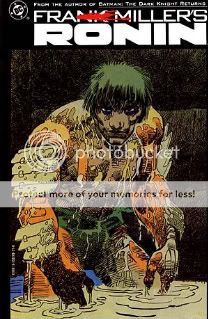Ronin
Frank Miller, writer/artist
DC, 1984
302 pages
$19.99
If The Dark Knight Strikes Again is Frank Miller’s brain on SPX, I suppose Ronin is Frank Miller’s brain on Shogun Assassin. I’d say Lone Wolf and Cub proper or some other manga touchstone, but the thing is that my own comparative ignorance of Japanese comics and Miller’s enormous influence on Western ones make it hard for me to see evaluate this formally as anything but a Frank Miller Comic that happens to use samurai and Akira-style science fiction.
It’s a very good Frank Miller Comic in fact. Back then his art had this doodly/sketchy quality—lots of little loops and bubbles and curlicues—that had yet to solidify into the hyperrealist noir of the first Sin City chapters in Dark Horse Presents and thence to recede to the chunky bigfoot self-satire of DKSA or the later Sin City books. It’s a bold style, perfect for conveying enormity by expanding the blobby details to the edge of the page or isolating action by stripping them away and letting the remaining figures slash through them. It’s also beautifully colored by Miller’s now ex-collaborator Lynn Varley; no one has used greens this effectively before or since.
Storywise it combines the familiar Japanese pulp tropes mentioned above with the uniquely Millerian idiom of topless black bondage Nazi gangs (cf. The Dark Knight Returns, Sin City), evil corporations painted with an hilariously broad satirical brush (cf. Hard Boiled), and sinister omnipotent female computer programs (cf. Martha Washington–man, if in some future FM Batman comic the Batcomputer ever gets referred to as “she,” watch out). But moreso than in any Miller comics save perhaps his collaborations with David Mazzuchelli, there’s a refreshing space left for the human element. While there’s obviously a lot of “he is the Hero, he is everything” to be found here, much of the plot is driven by the comparatively quotidian doings of the Aquarius Complex’s worker bees: middle management, staff psychiatrists, laborers pissed off at the treatment of the fellow workers, an idealistic scientist and his security-guard girlfriend whose story of success-driven estrangement would fit nicely into a late-’90s period piece about a dot-com startup. So it’s easy to forgive some narrative lapses, like a jarring bit of told-not-shown infodumping about how the ronin entered the modern world whose raison d’etre only becomes apparent at the end of the story, and simply focus on the pleasures of the art and the tempered-gonzo writing. Capping it all off is a brancinglysudden ending and final image of triumph-through-simply-existing that I really wish more genre comics would ape. I will enjoy rereading this comic every four years or so until I die.
Tags: comics, comics reviews, Comics Time, reviews


Ahhh, Ronin. It’s about time for me to re-read it, come to think of it. It’s lumpy as hell, but the good parts are so good, and it’s so vigorous without the pushiness that I find common in Miller’s later work – more “and let’s go see the next amazing thing!”, less “see, bub, huh, see, now say you like it or I shove you again”.
“No one has used greens this effectively before or since.”
Well. Al Gore.
The only thing I remember about Ronin is that when the guy was newly resurrected or whatever, somebody tricked him into saying the n-word. TO an n-world. Whoa buddy.
N-word, n-world, whatevler.
By the way, though I no longer remember the names, a friend of mine steeped in manga said that the style in Ronin showed a lot of borrowing but no swiping. He compared it to an art style that had some of P. Craig Russell’s anatomy, some of Scott McCloud’s rendering, and some of ‘Beto Hernandez’s compositions – an informed viewer can see the influences but it’s still very distinctive.
Another big influence here, that shouldn’t be ignored and I’m surprised that no one has mentioned, is Moebius. Miller alluded to as much in interviews around the time this came out, and it’s especially clear in the parts of the story that take place in that green quasi-organic techno complex.
Looking back, you can see how RONIN was Miller working through his Moebius/Lone Wolf influences in the way that DAREDEVIL (at least in the later part of the original run) was Miller working through his Eisner/Lone Wolf influences. It was the samurai stuff that bridged that gap, obviously. I haven’t read this in a while, but I’m looking forward to the Absolute edition.
Public Enemy – “Fight the Power”
The first hip-hop song I ever loved, “Fight the Power” is arguably the greatest hip-hop song ever, but part of me thinks Spike Lee’s video for it is even better. Every time I see it I find myself astonished…